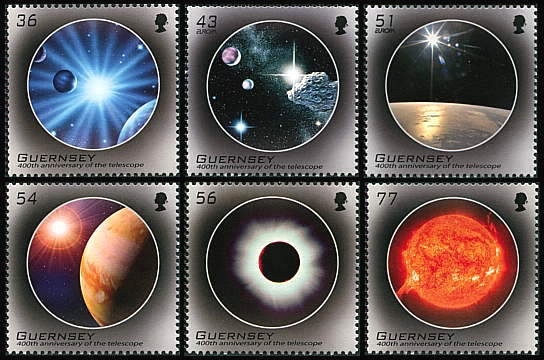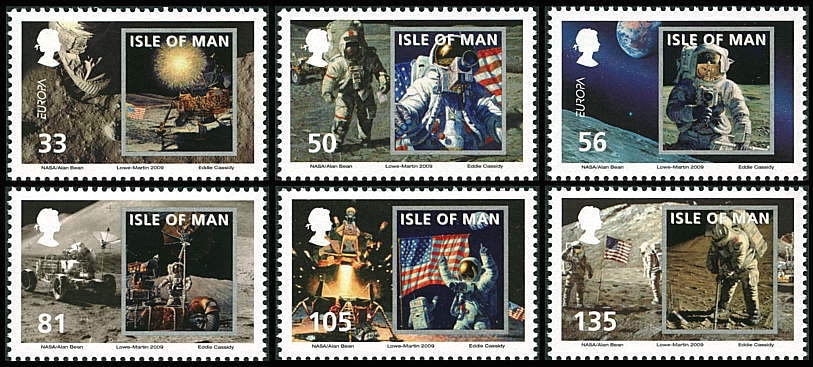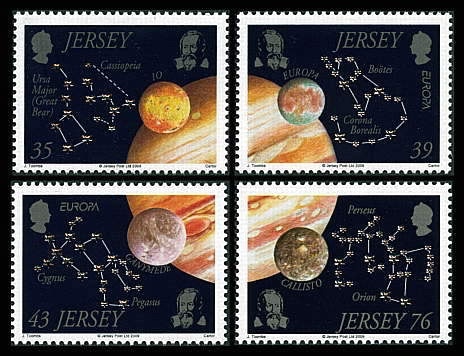2009 International Year of Astronomy
The International Year of Astronomy in 2009 commemorated the 400th anniversary of the first use of an astronomical telescope by the Italian scientist Galileo Galilei, who saw among other wonders the craters of the Moon, the satellites of Jupiter, and sunspots. England celebrated the achievements of Thomas Harriot, an Englishman who beat Galileo by several months but remains much less well known.
In recognition of the IYA, Astronomy was the theme of the 2009 Europa stamps issued by the members of PostEurop, the trade association of European public postal operators which succeeded the European Conference of Postal and Telecommunications Administrations (CEPT) in 1993.
400th anniversary of the telescope (Guernsey)
Guernsey produced a set of six stamps for IYA under the title ‘400th Anniversary of the Telescope’. Only two of them (the 43p and 51p values) were designated as Europa issues, distinguishable by the Europa name underneath the price.
The six designs and their face values were:
• 36p, quasar;
• 43p, asteroid;
• 51p, the Sun and Earth as seen from orbit;
• 54p, Jupiter, with the Sun beyond;
• 56p, total solar eclipse;
• 77p, the Sun as seen from the SOHO spacecraft.
The text in the presentation pack for the stamps jointly credited Galileo and Thomas Harriot for the first astronomical use of the telescope.
Each of the six stamps also came in sheets of ten with descriptive wording in the margin. The issue date was 2009 May 28.
Stanley Gibbons nos. 1284–1289
Man on the Moon (Isle of Man)
Always keen to play on the word ‘Man’ in its name, Isle of Man Post chose Man on the Moon as the subject of its 2009 astronomy offering issued on April 12, a date which happened to be the 48th anniversary of the first manned spaceflight by Yuri Gagarin. Six stamps featured views from the six Apollo missions that landed successfully on the Moon (Apollo 13 was, of course, a famous failure). Two members of the set – the 33p and 56p values – were designated as Europa issues, as indicated by the Europa name on their left. The illustrations on the stamps were a mixture of real photographs and paintings by Apollo 12 astronaut Alan Bean, who has become an artist since his astronaut days. The six stamps were as follows:
33p: Photograph of Apollo 11 astronaut Buzz Aldrin’s boot and imprint in the lunar soil, somewhat doctored from the original. The inset is a painting by Bean of the Sun glinting off the Apollo 14 lunar module Antares, based on a real photo. This was one of the two stamps in the set designated as Europa issues, and was also available in a sheet of ten with illustrated border.
50p: Both illustrations on this stamp are paintings by Alan Bean. The inset is intended as a self-portrait of Bean on the Moon, while in the background Apollo 16 commander John Young is seen picking up a sample from the lunar surface, based on this black-and-white original.
56p: The inset is from a Bean painting titled Pete and Me. It shows Apollo 12 commander Pete Conrad snapping a picture of Bean, with Bean reflected in Conrad’s visor – a homage to the classic picture of Buzz Aldrin taken by Neil Armstrong on the Apollo 11 mission. This painting is based on a real photograph. The background image is the curve of the lunar limb with the Earth above. This was the second of the two Europa issues in the set, and was also available in a sheet of ten with illustrated border.
81p: The background image is a real photograph of Apollo 15 commander Dave Scott alongside the electrically powered Moon car, properly known as the Lunar Roving Vehicle (LRV), on the edge of Hadley Rille, with mount Hadley Delta looming behind. The inset is a Bean painting titled Heading for the Last Parking Lot, based on a photograph of Apollo 17 commander Gene Cernan who had just offloaded the final consignment of rock and soil samples from the LRV before leaving it behind on the Moon.
105p (£1.05): Two paintings by Bean. The main image is called The Eagle is Headed Home, a depiction of the top half of the Apollo 11 lunar module taking off from the Moon with Neil Armstrong and Buzz Aldrin aboard. The inset is called In the Beginning, intended as a symbolic celebration of the first manned lunar landing.
135p (£1.35): Another two paintings by Bean. In the first, Apollo 15 astronauts David Scott and James Irwin salute the US flag at their landing site near Hadley Rille. The inset shows Irwin digging in the lunar soil, taken from this photograph.
All six stamps were available in sheets of 25 with illustrated borders.
An adjunct to this set was a miniature sheet containing a stamp of face value £2.50, again illustrated by Alan Bean. The painting on the £2.50 stamp is titled On the Rim, and depicts Apollo 16 astronauts John Young and Charlie Duke with their Lunar Roving Vehicle on the rim of a small impact crater called North Ray Crater. Bean based the painting on this distant view of Duke at the LRV taken by Young.
On 2009 July 20, the date of the Apollo 11 landing, this sheet was reissued with the addition of a small panel reading ‘40th anniversary man on the moon’.
Stanley Gibbons nos. 1513–1518. The SG number of the mini sheet is MS1519
Europa Astronomy/IYA (Jersey)
Jersey Post was the first of the postal authorities in the British Isles off the mark with its 2009 astronomy stamps, bringing out a set of four on February 6. Each stamp showed one of the four Galilean satellites of Jupiter plus a small portrait of Galileo, with a segment of Jupiter in one corner. When the four stamps are put together, as above, the segments form a complete disk of Jupiter. On each stamp, the outlines of two constellations were picked out by embossed silver stars. The eight constellations were chosen by members of the Jersey Astronomy Club.
The illustrations on the four stamps are as follows:
• 35p, Io with Ursa Major and Cassiopeia;
• 39p, Europa with Boötes and Corona Borealis;
• 43p, Ganymede with Cygnus and Pegasus;
• 76p, Callisto with Perseus and Orion.
As with Guernsey and the Isle of Man, only two of the stamps were designated as Europas, in this case the 39p and 43p values.
All four stamps were also produced in sheets of ten, with the same eight constellations in the sheet margins as on the stamps.
Stanley Gibbons nos. 1417–1420


